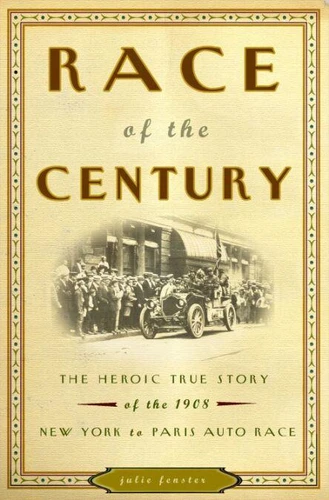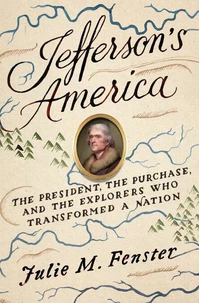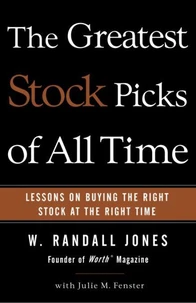Race of the Century. The Heroic True Story of the 1908 New York to Paris Auto Race
Par :Formats :
Disponible dans votre compte client Decitre ou Furet du Nord dès validation de votre commande. Le format ePub protégé est :
- Compatible avec une lecture sur My Vivlio (smartphone, tablette, ordinateur)
- Compatible avec une lecture sur liseuses Vivlio
- Pour les liseuses autres que Vivlio, vous devez utiliser le logiciel Adobe Digital Edition. Non compatible avec la lecture sur les liseuses Kindle, Remarkable et Sony
- Non compatible avec un achat hors France métropolitaine
 , qui est-ce ?
, qui est-ce ?Notre partenaire de plateforme de lecture numérique où vous retrouverez l'ensemble de vos ebooks gratuitement
Pour en savoir plus sur nos ebooks, consultez notre aide en ligne ici
- Nombre de pages400
- FormatePub
- ISBN0-307-23849-0
- EAN9780307238498
- Date de parution14/06/2005
- Protection num.Adobe DRM
- Taille2 Mo
- Infos supplémentairesepub
- ÉditeurCrown
Résumé
On the morning of February 12, 1908, six cars from four different countries lined up in the swirling snow of Times Square, surrounded by a frenzied crowd of 250, 000. The seventeen men who started the New York to Paris auto race were an international roster of personalities: a charismatic Norwegian outdoorsman, a witty French count, a pair of Italian sophisticates, an aristocratic German army officer, and a cranky mechanic from Buffalo, New York.
President Theodore Roosevelt congratulated them by saying, "I like people who do something, not the good safe man who stays at home." These men were doing something no man had ever done before, and their journey would take them very far from home. Their course was calculated at more than 21, 000 miles, across three continents and six countries. It would cross over mountain ranges-some as high as 10, 000 feet-and through Arctic freeze and desert heat, from drifting snow to blowing sand.
Bridgeless rivers and seas of mud blocked the way, while wolves, bears, and bandits stalked vast, lonely expanses of the route. And there were no gas stations, no garages, and no replacement parts available. The automobile, after all, had been sold commercially for only fifteen years. Many people along the route had never even seen one. Among the heroes of the race were two men who ultimately transcended the others in tenacity, skill, and leadership.
Ober-lieutenant Hans Koeppen, a rising officer in the Prussian army, led the German team in their canvas-topped 40-horsepower Protos. His amiable personality belied a core of sheer determination, and by the race's end, he had won the respect of even his toughest critics. His counterpart on the U. S. team was George Schuster, a blue-collar mechanic and son of German immigrants, who led the Americans in their lightweight 60-horsepower Thomas Flyer.
A born competitor, Schuster joined the U. S. team as an undistinguished workman, but he would battle Koeppen until the very end. Ultimately the German and the American would be left alone in the race, fighting the elements, exhaustion, and each other until the winning car's glorious entrance into Paris, on July 30, 1908. Lincoln's Birthday, February 12, 1908 .
President Theodore Roosevelt congratulated them by saying, "I like people who do something, not the good safe man who stays at home." These men were doing something no man had ever done before, and their journey would take them very far from home. Their course was calculated at more than 21, 000 miles, across three continents and six countries. It would cross over mountain ranges-some as high as 10, 000 feet-and through Arctic freeze and desert heat, from drifting snow to blowing sand.
Bridgeless rivers and seas of mud blocked the way, while wolves, bears, and bandits stalked vast, lonely expanses of the route. And there were no gas stations, no garages, and no replacement parts available. The automobile, after all, had been sold commercially for only fifteen years. Many people along the route had never even seen one. Among the heroes of the race were two men who ultimately transcended the others in tenacity, skill, and leadership.
Ober-lieutenant Hans Koeppen, a rising officer in the Prussian army, led the German team in their canvas-topped 40-horsepower Protos. His amiable personality belied a core of sheer determination, and by the race's end, he had won the respect of even his toughest critics. His counterpart on the U. S. team was George Schuster, a blue-collar mechanic and son of German immigrants, who led the Americans in their lightweight 60-horsepower Thomas Flyer.
A born competitor, Schuster joined the U. S. team as an undistinguished workman, but he would battle Koeppen until the very end. Ultimately the German and the American would be left alone in the race, fighting the elements, exhaustion, and each other until the winning car's glorious entrance into Paris, on July 30, 1908. Lincoln's Birthday, February 12, 1908 .
On the morning of February 12, 1908, six cars from four different countries lined up in the swirling snow of Times Square, surrounded by a frenzied crowd of 250, 000. The seventeen men who started the New York to Paris auto race were an international roster of personalities: a charismatic Norwegian outdoorsman, a witty French count, a pair of Italian sophisticates, an aristocratic German army officer, and a cranky mechanic from Buffalo, New York.
President Theodore Roosevelt congratulated them by saying, "I like people who do something, not the good safe man who stays at home." These men were doing something no man had ever done before, and their journey would take them very far from home. Their course was calculated at more than 21, 000 miles, across three continents and six countries. It would cross over mountain ranges-some as high as 10, 000 feet-and through Arctic freeze and desert heat, from drifting snow to blowing sand.
Bridgeless rivers and seas of mud blocked the way, while wolves, bears, and bandits stalked vast, lonely expanses of the route. And there were no gas stations, no garages, and no replacement parts available. The automobile, after all, had been sold commercially for only fifteen years. Many people along the route had never even seen one. Among the heroes of the race were two men who ultimately transcended the others in tenacity, skill, and leadership.
Ober-lieutenant Hans Koeppen, a rising officer in the Prussian army, led the German team in their canvas-topped 40-horsepower Protos. His amiable personality belied a core of sheer determination, and by the race's end, he had won the respect of even his toughest critics. His counterpart on the U. S. team was George Schuster, a blue-collar mechanic and son of German immigrants, who led the Americans in their lightweight 60-horsepower Thomas Flyer.
A born competitor, Schuster joined the U. S. team as an undistinguished workman, but he would battle Koeppen until the very end. Ultimately the German and the American would be left alone in the race, fighting the elements, exhaustion, and each other until the winning car's glorious entrance into Paris, on July 30, 1908. Lincoln's Birthday, February 12, 1908 .
President Theodore Roosevelt congratulated them by saying, "I like people who do something, not the good safe man who stays at home." These men were doing something no man had ever done before, and their journey would take them very far from home. Their course was calculated at more than 21, 000 miles, across three continents and six countries. It would cross over mountain ranges-some as high as 10, 000 feet-and through Arctic freeze and desert heat, from drifting snow to blowing sand.
Bridgeless rivers and seas of mud blocked the way, while wolves, bears, and bandits stalked vast, lonely expanses of the route. And there were no gas stations, no garages, and no replacement parts available. The automobile, after all, had been sold commercially for only fifteen years. Many people along the route had never even seen one. Among the heroes of the race were two men who ultimately transcended the others in tenacity, skill, and leadership.
Ober-lieutenant Hans Koeppen, a rising officer in the Prussian army, led the German team in their canvas-topped 40-horsepower Protos. His amiable personality belied a core of sheer determination, and by the race's end, he had won the respect of even his toughest critics. His counterpart on the U. S. team was George Schuster, a blue-collar mechanic and son of German immigrants, who led the Americans in their lightweight 60-horsepower Thomas Flyer.
A born competitor, Schuster joined the U. S. team as an undistinguished workman, but he would battle Koeppen until the very end. Ultimately the German and the American would be left alone in the race, fighting the elements, exhaustion, and each other until the winning car's glorious entrance into Paris, on July 30, 1908. Lincoln's Birthday, February 12, 1908 .






